.jpg)
Don’t you think that Google ads marketing tips when it comes to ecommerce is just a bunch of…common sense?
I mean, launching certain campaign types is, of course, necessary for any ecom brand. Doing more of what’s working and scaling by increasing budgets and bids is also commonly known.
And there’s only so many new products you can add or strategies you can try. But something we know over at Yoru Marketing is there’s more to the overall scene.
There’s more you can do that can actually move the needle within your business without spending any significant budget on doing the common things.
But most ecom store owners would rather spend their valuable ad budget blindly on campaign after campaign or strategy after strategy without taking the time to analyze their entire funnel.
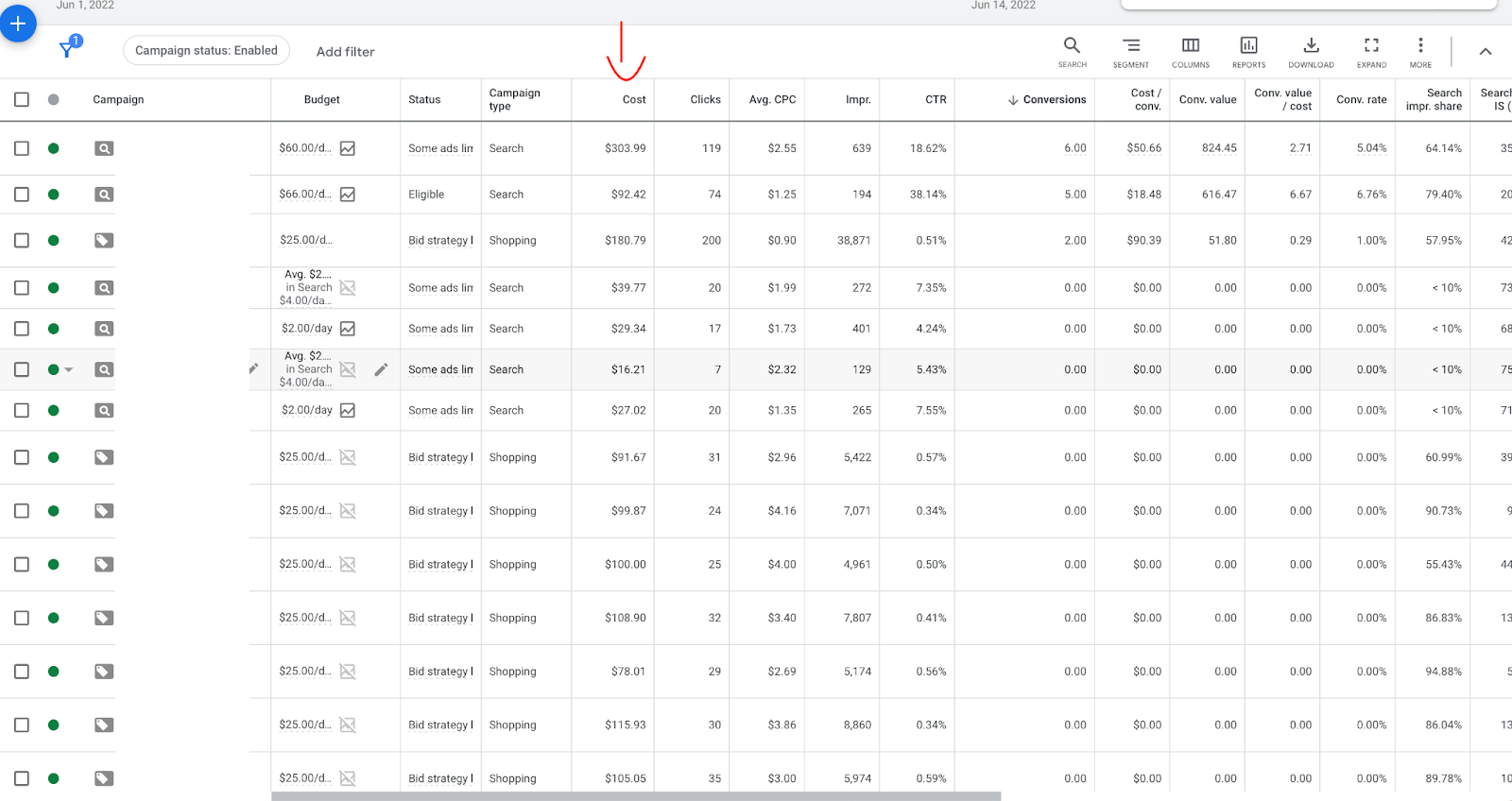
And that’s exactly why so many ecommerce brands fail in the long run.
Don’t worry though, because in this post, we’ll be telling you the not-so-common things that can help you grow further with Google ads in no time.
What it takes
Finding success with Google Ads is much more than just having the right products or certain types of campaigns. It involves strategy. Analysis. Optimization, both on the frontend and the backend.
And way too many ecommerce store owners lose sight of this. They end up spending countless hours clicking on things within campaigns hoping those edits and changes move the needle.

While it is true that consistent optimizations are needed, it’s also just as important to ensure time is spent effectively improving other parts of the funnel. Here are a few important pieces you need to have right:
- CTR (images)
- CRO (Landing Page Experience)
- Click / Search Impression Share
- AD Relevance
- AOV
Lets go through each one.
CTR
Most ecommerce store owners running Google ads don’t realize just how important an image is to the overall success of a product. And there’s no better way to illustrate this than by going back to a personal experience.
In the summer months of 2020, I came across a grass trimmer through eBay which I wanted to sell on my store. It was a very basic product but due to the season we were in, I decided to give it a try.
I realized after I added the product to my store and running it for a few weeks that it wasn’t moving. I was getting 0 sales for it and patience was running out. Before completely excluding it, I decided to give it one final try.

I had noticed many of our competitors (about 97%) had the same product on a white background with just the product in front. There was a lifestyle image of someone using the product I had recently found while searching and I decided to give this one a try.
I was in disbelief when I opened my Google ads dashboard the very next day to see Google pumping large amounts of budget to it. By the end of that day, I had gotten about seven sales for the product and eventually, it made around $20,000 in extra revenue at a profit.
Know what’s crazy?
I changed the price a couple of days later to $50 more than what it originally was at for added profits. And despite the higher price compared to competitors, it sold like hot cakes.
The power of image is real and you need to utilize them properly. But this brings me to the next important metric: the landing page experience
CRO
Conversion rate optimization occurs at a greater level but we’re going to direct it towards the landing page itself. Because after all, the landing page experience is one of the determining factors of your Google ads campaign’s quality score.
Quality Score = Landing Page Experience + Expected CTR + AD Relevance

Since the landing page experience a consumer has is one of the deciding factors of your quality score, which ultimately decides the success of your campaigns, it makes sense to pay more attention to it. One thing I always do for my ecommerce brand is split test.
Colors, trust badges, image styles, overall layouts, etc. Whatever can help me increase the experience which will increase the amount of time a user spends on my website and improves this metric.
Do this well and this impacts the next most important metric.
Click / search impression share
By now, if you’ve just focused on the metrics prior to this, the Google ads algorithm has probably started to push your shopping and / or search ads more the the front at lower ad costs.
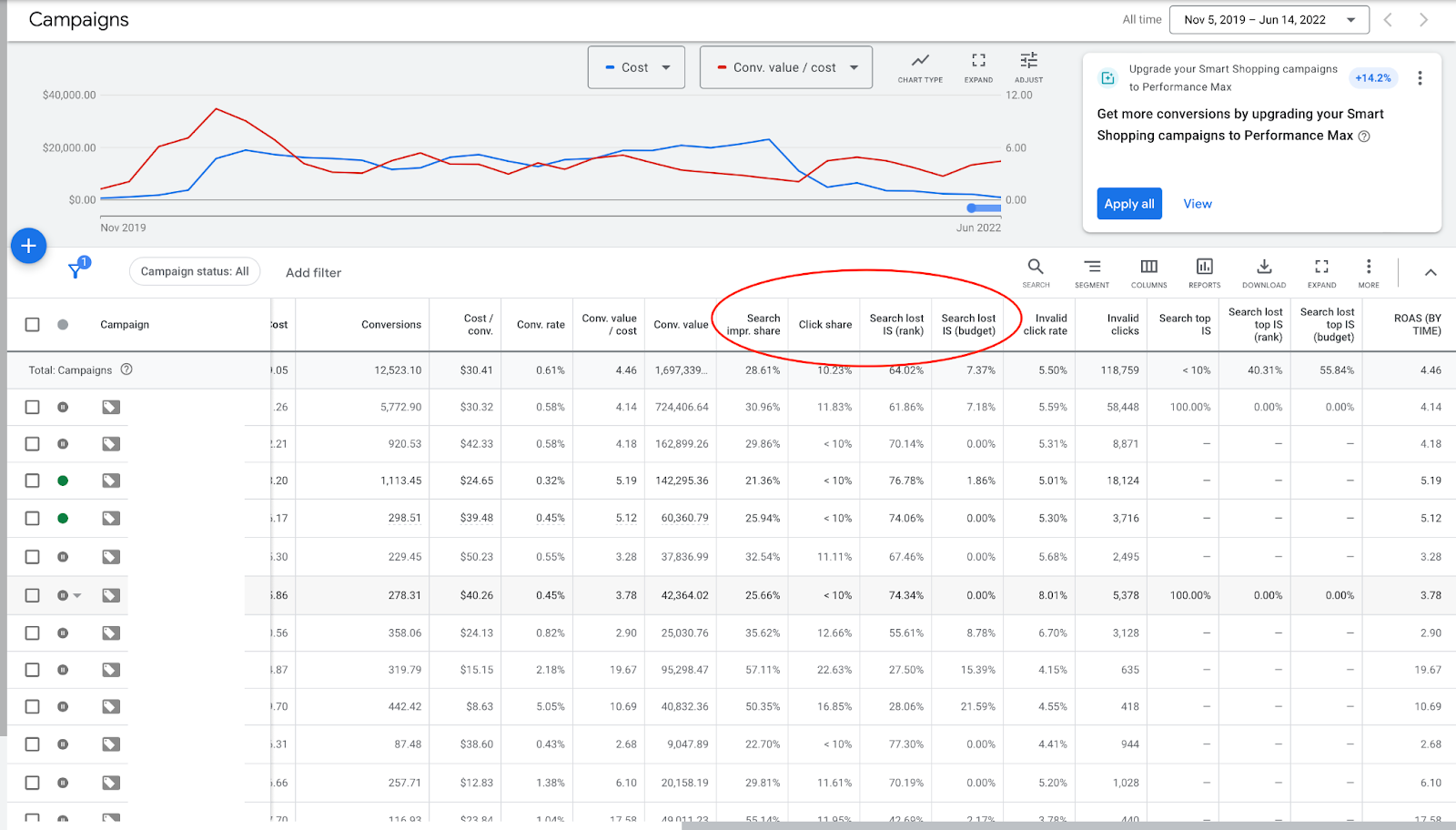
When this happens, your click and search impression share metrics begin to increase. More people begin to see and interact with your products and ads, causing a surge in traffic.
Over time, this ends up turning into what we like to call the ‘snowball effect’ where things just begin to spiral and get bigger and bigger.
More traffic. More sales. More customers.
At a scale like this, your ads can often start showing for irrelevant keywords and search terms. This is where our next metric comes into play.
AD relevance
With Google ads, it’s always best to rank for keywords as closely related to your products and collections as possible. And this goes back to our main topic of common sense.
While this is something that every Google ads user should know, many fail to implement it properly. And this causes a lot of wasted ad spend on completely broad search terms.
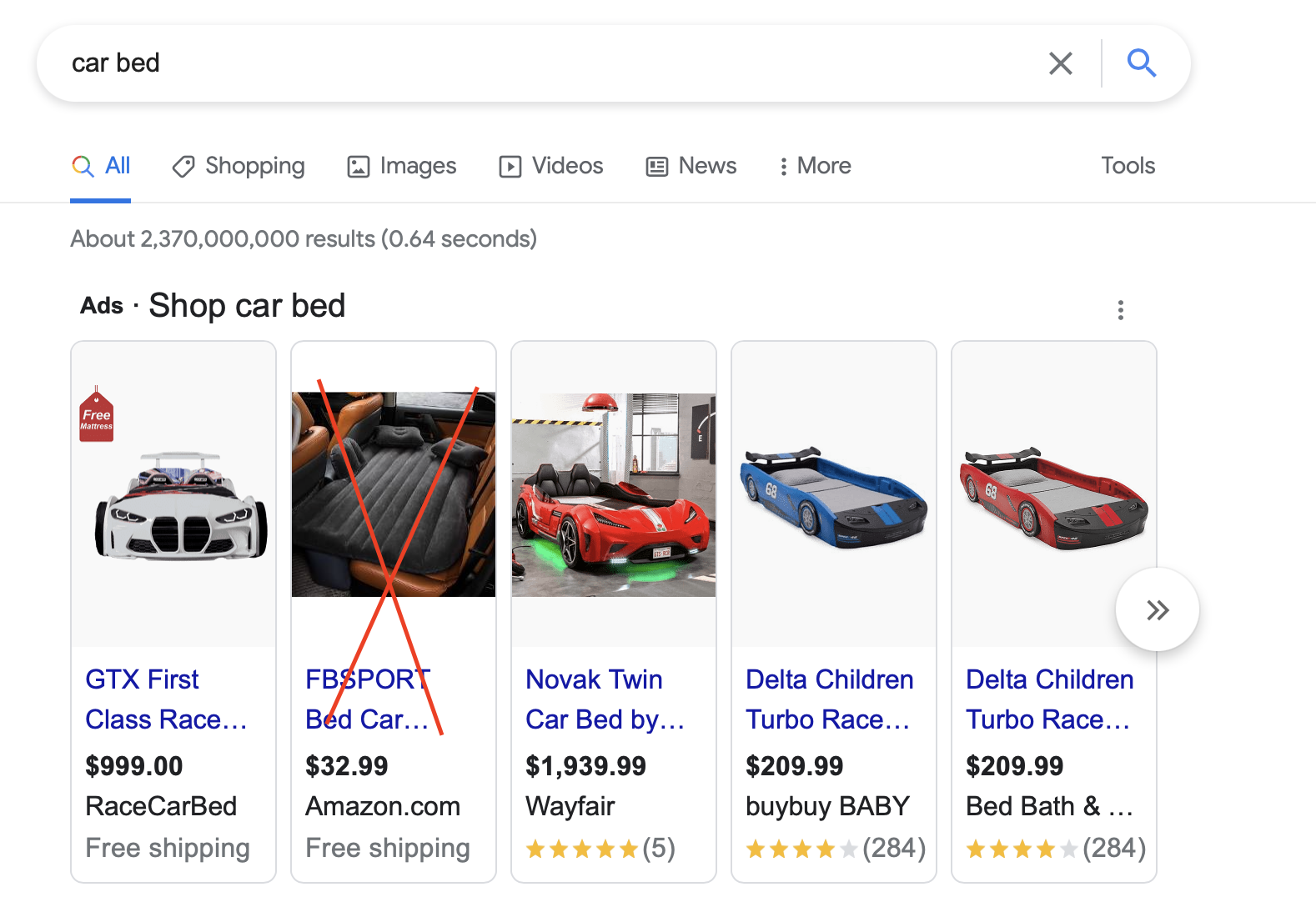
To illustrate this situation a bit further, lets use an example.
If we pretend that we’re selling a specific model of a 3D printer, it makes sense to rank for 3D printer related keywords. However, at scale, it’s very common to begin ranking for terms such as “printer” or “printer ink” or “printer stand”. While these keywords have our main search term, they are not related to what we sell.
Proper keyword management is one of the most necessary components of a successful Google ads strategy. But without our final metric, everything else is rendered useless.
AOV
Without a decent average order value, you do not have a business. Have an AOV of less than $30 and you risk going in a loss running Google ads.
Due to this, it makes sense to put a bit more emphasis on having a decent AOV. One that can ensure you have enough to pay your operating expenses and all other fees while keeping profits in your pockets.
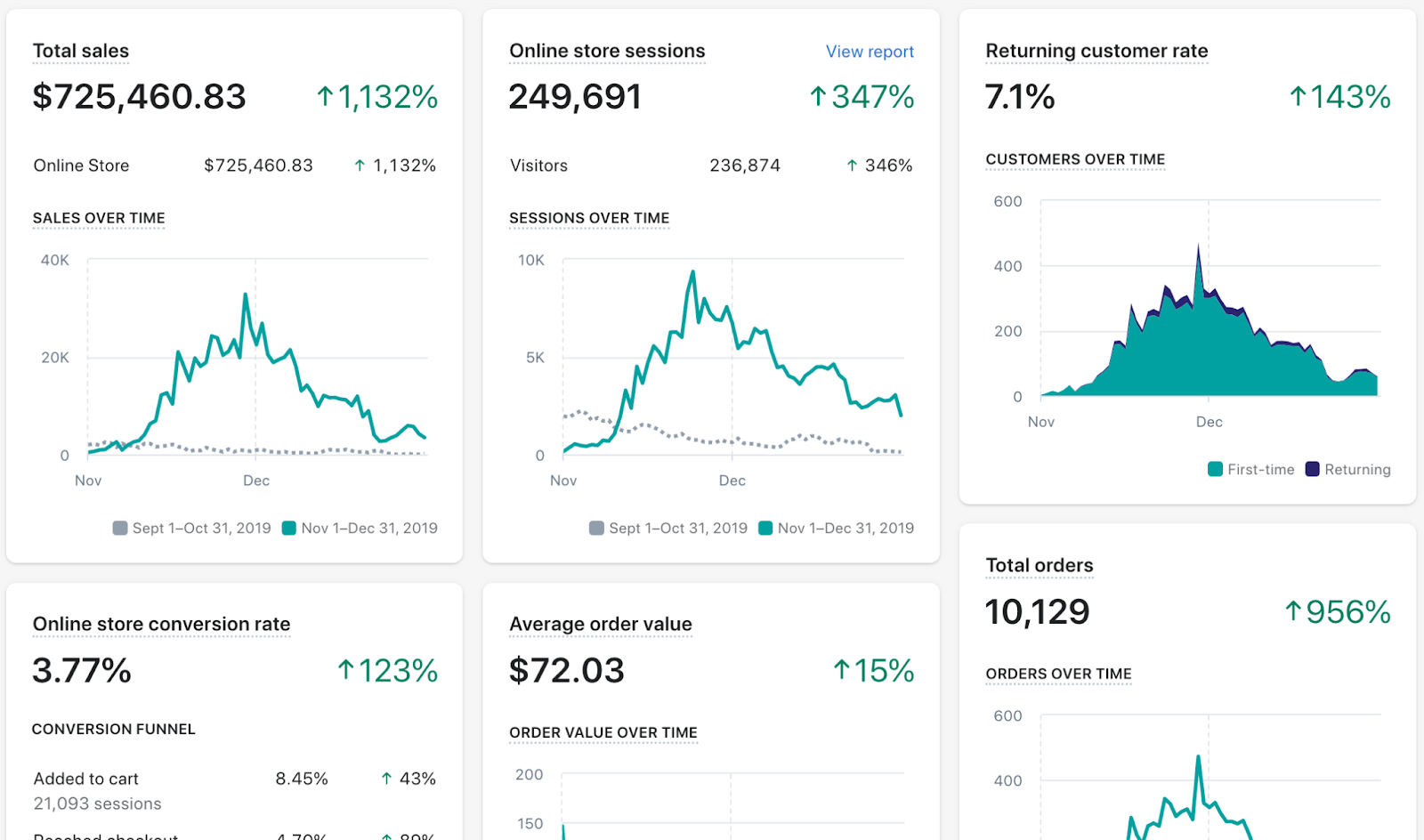
I know AOV was the main reason why my own ecommerce brand had a 10%+ net profit margin on a consistent basis. And this was only possible due to upsells and downsells.
Upsells and downsells act as the buffer between cold targeting and profits; one doesn’t harm the other. But upsells and downsells need to be strategically done in order to maximize profits.
Creating a strong foundation
By now, it’s pretty obvious just HOW important a lot of external factors are to the success of Google Ads. And while every single one of these factors should be focused on to attain the best possible approach towards profitability, I want to focus on AOV a bit more.
Ah, the smell of…a high value order. It smells like a lot of dollar bills.
But how can an ecommerce store owner using Google ads get such high value orders consistently? Personally, I’ve been running Google Ads for years and I’ve noticed that simple things work the best.

Especially with AOV.
You can try a plethora of different upsell and downsell strategies but without a strong foundation, the extra revenue will be minimal. And when it comes to upsells and downsells, the foundation is the app you decide to use itself.
The Shopify app I’ve had the most success with is Aftersell.
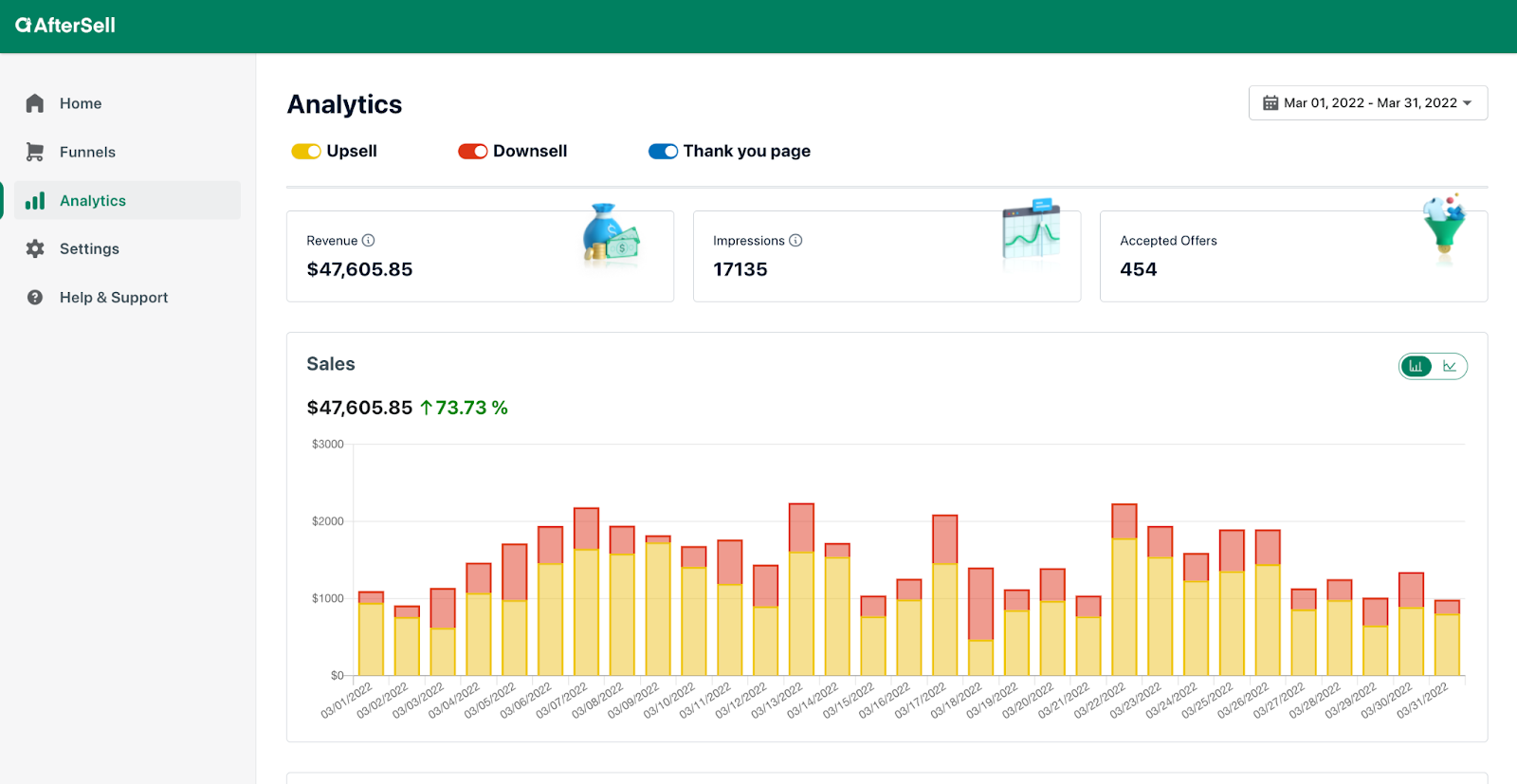
Increase your average order value
We’re always looking for ways to increase average order value, but what truly solves this? One of the top modern solutions to this challenge is post purchase offers with Aftersell.
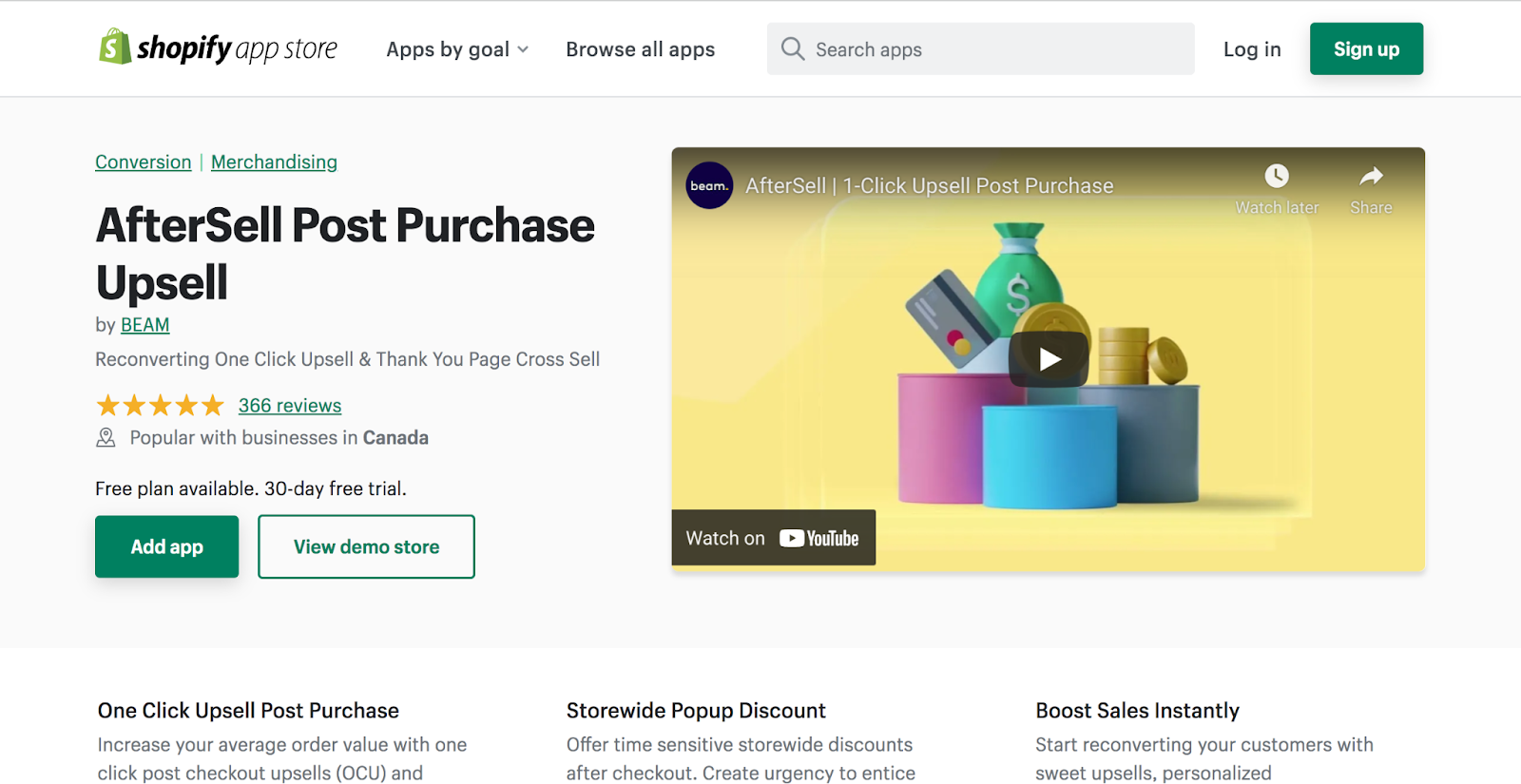
What is an Aftersell post purchase upsell?
Aftersell post purchase upsells are offers that, in the truest sense, show up at the right place at the right time. As soon as the customer completes their purchase, they are provided with a compelling offer that they can add to their order with a single click (there is no need to re-enter credit card information).

There are a number of offer types and strategies for these upsells. You can offer…
- A subscription (add a monthly replacement)
- More units of the original product at a discount (add a second t-shirt)
- A complementary product (add a cutlery set to compliment your new lunchbox)
Always consider the value your offer provides to the customer’s purchase. Try to maximize this for the best results.
Why do post purchase upsells just work?
When you are at a fast food burger joint, you might be offered some sides before you pay. It would be quite odd if they asked you “would you like fries with that?” after you already paid.
However, that is only true in the offline world. In the online world it is surprisingly quite the opposite. Why?
First, you have built a sense of trust.
When a shopper has made an online purchase, they get a surge of dopamine. They feel euphoric; this feeling is often associated with high trust. With the right post purchase offer you can offer a great deal to your customers that they are more likely to accept.
Second, you don’t jeopardize the initial purchase
We’ve all browsed an ecommerce site where we’re attacked with popups, email collectors, discounts, opt-in requests, flash sales, and more. It’s never a pleasant experience and as you expect leads customers to abandon their purchase. The post purchase upsell removes this risk altogether by changing the location of the offer.
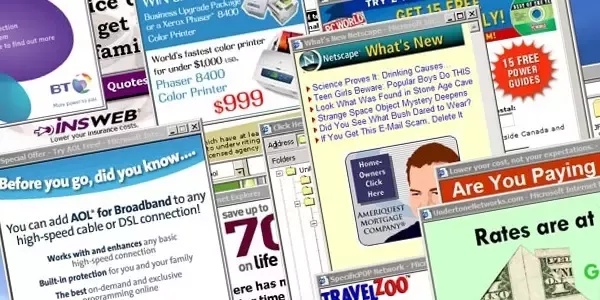
Third, you can build a sense of urgency
Imagine making a purchase and being greeted with a special offer: 30% off for the next 20 minutes. That second handbag you reluctantly removed from your cart as a gift for mom? Well, now you can buy that! Who would want to miss out on a deal of a lifetime?
What to consider when creating Aftersell upsells on your store
It’s not always just about the product you offer, how you present your offer can have a big impact on how it performs.
While you are building out your AfterSell funnel, these are the top principles to remember:
- Conversion rate optimization
- Data backed Decisions
- Thank you page design
Conversion rate optimization
Let’s say you show your customer the first upsell and they decline. No worries, show them another offer!
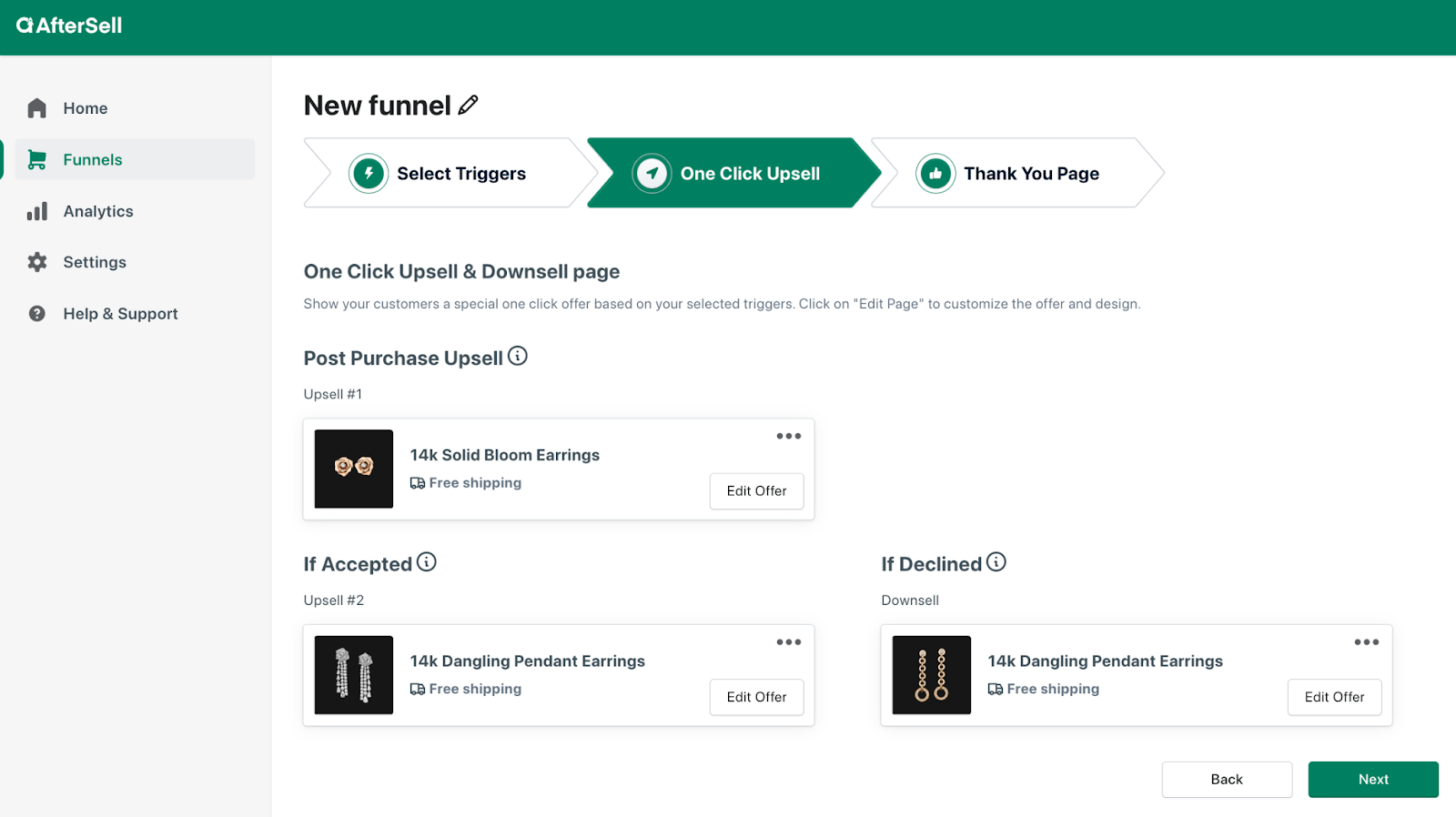
With Aftersell, you can also add social proof with customer reviews, incite urgency with timer bars, and write personalized copy to really “sell” the product.
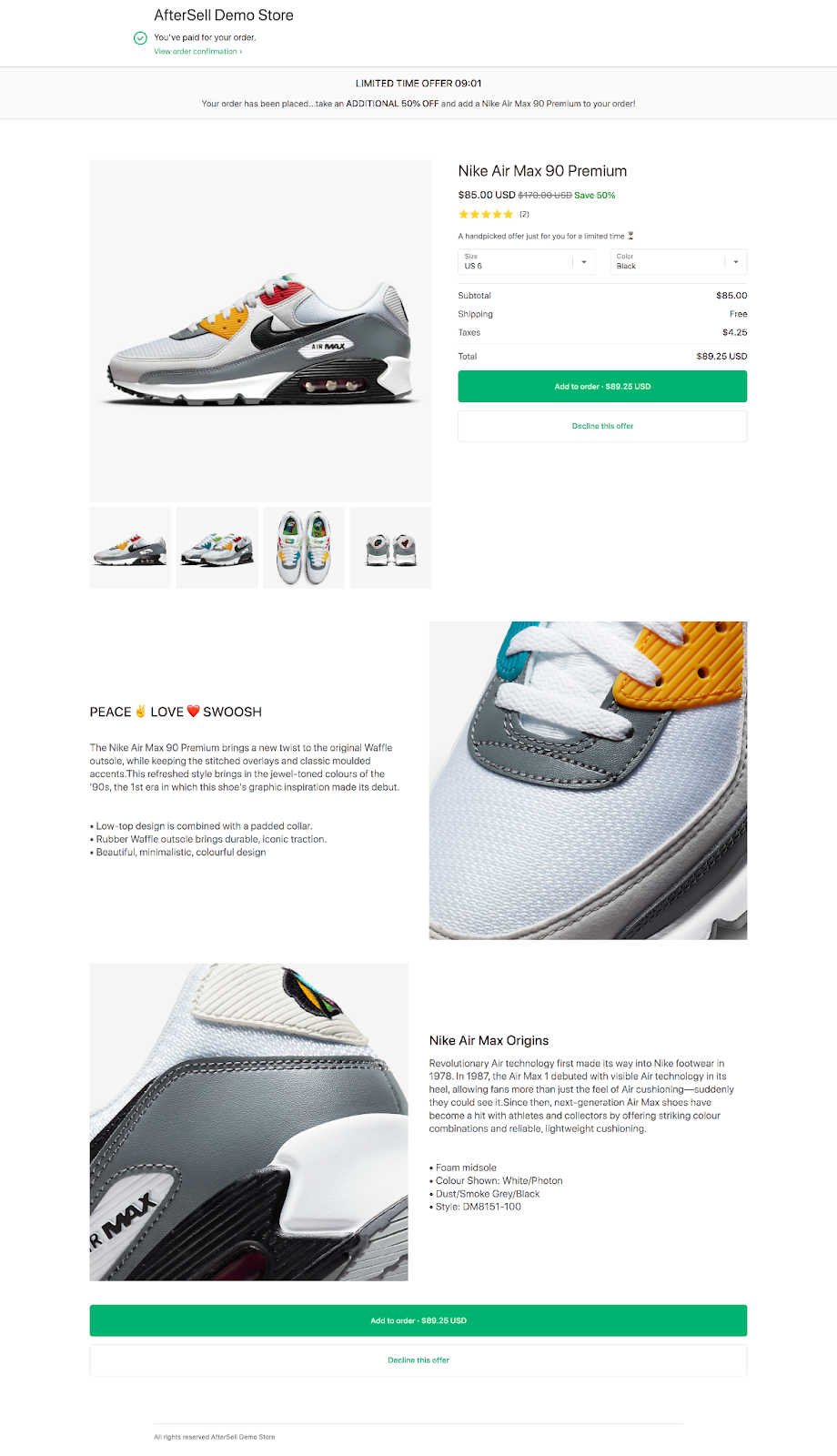
Data-backed decisions
When setting up your Aftersell offers, you might be thinking, how do I know which product will perform the most optimally? The answer is testing! In Aftersell you can set up “A/B tests” that allow you to find the best offer for your customers.

Thank you page design
To get the most out of Aftersell, make sure you add widgets to your order confirmation “thank you page”. You can add a variety of widgets including frequently asked questions, customer testimonials, collection offers and more!
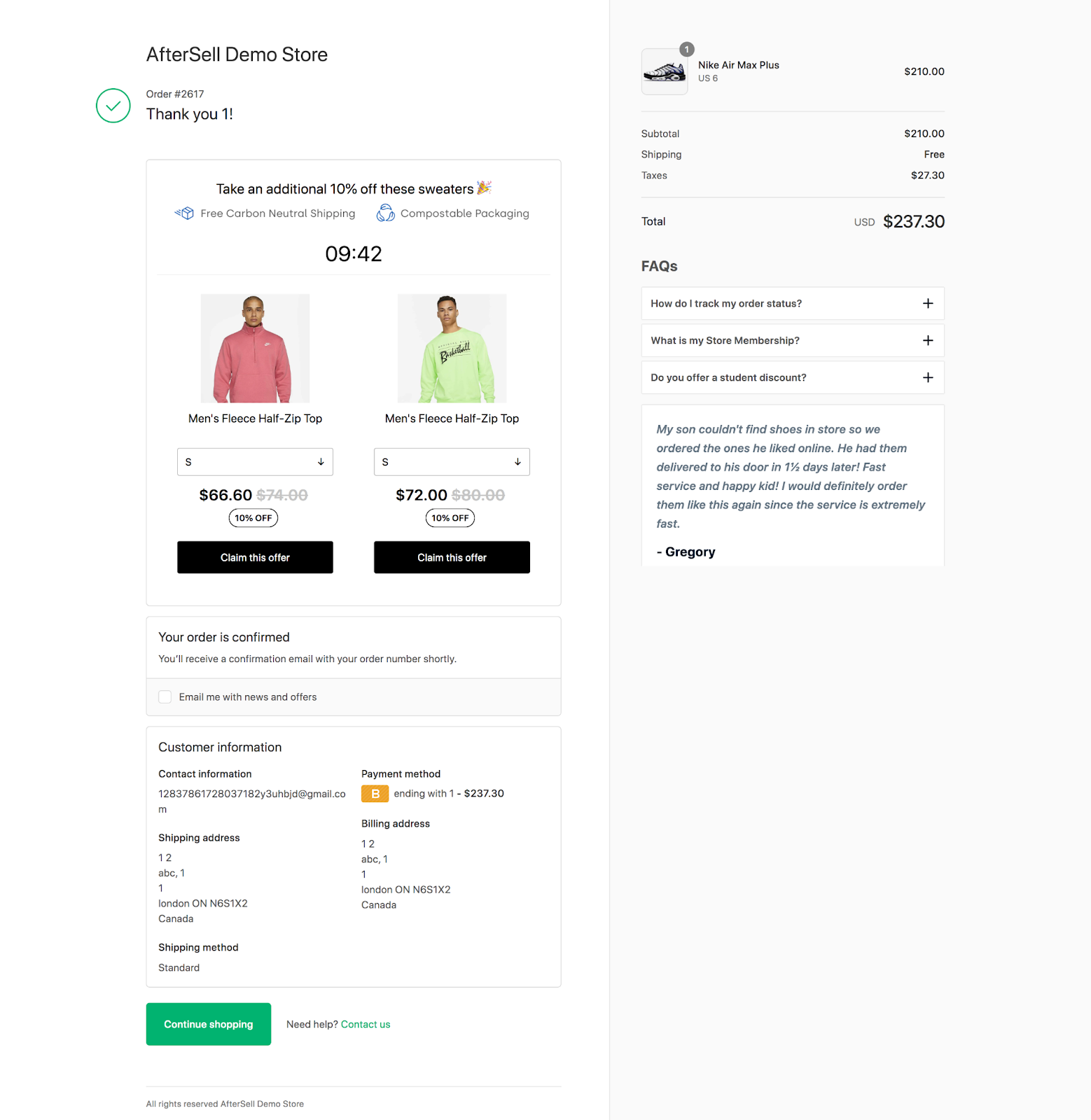
Using Aftersell for post purchase offers is one of the leading ways to boost your AOV by over 18%! When scaled up across your entire customer base, this offer type can have dramatic impacts on your bottom line. Aftersell is trusted by ecommerce brands like Feastables, Good American, Cotopaxi, and thousands more. Try it free for 30 days on the Shopify app store.
Recommended Reading







